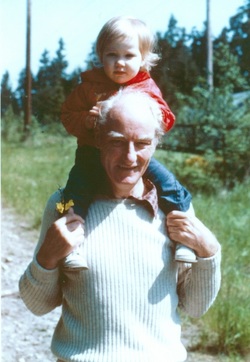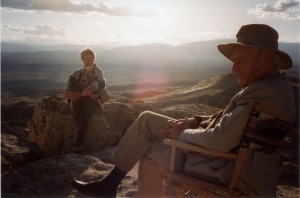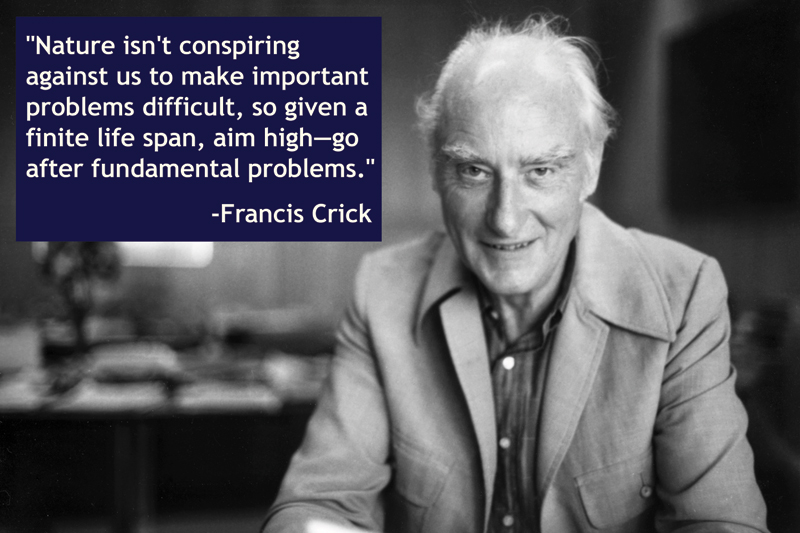My granddad, scientist Francis Crick, and the secret of life

In my favorite photograph of the two of us together, my granddad is carrying my toddler self on his shoulders. I’m holding onto his crown of white hair while he’s holding a wildflower that we must have plucked along the trail. This picture resonates with my most vibrant memories of my granddad as always full of kindness, laughter and lively conversation. It wasn’t until my 5th grade teacher suggested that I look him up in an encyclopedia that I realized that my granddad was also a scientist who had investigated and answered some of the most important scientific questions of the 20th century.
Francis Crick, along with James Watson, is famous for unraveling the double-helical structure of DNA and deducing from its chemical structure its key function of storing and copying genetic information. For this discovery and revolutionary insight, they were awarded the Nobel Prize in 1962. Some people today dismiss Watson and Crick’s work as theft, having been told that they stole Rosalind Franklin’s data. This is not true. A key bit of data they used came from an internal department report intended to share MRC findings between labs and from her initial critique of their incorrect structure. Rosalind Franklin’s data was key to the double helix model they built. The Watson-Crick model brings together additional data and adds two unique insights – the two spirals twisted in opposite directions allowing for specific base pairings (A-T and G-C) to fit neatly inside. They then made the leap that secured them the Nobel Prize: DNA was a code.
Francis Crick, along with James Watson, is famous for unraveling the double-helical structure of DNA and deducing from its chemical structure its key function of storing and copying genetic information. For this discovery and revolutionary insight, they were awarded the Nobel Prize in 1962. Some people today dismiss Watson and Crick’s work as theft, having been told that they stole Rosalind Franklin’s data. This is not true. A key bit of data they used came from an internal department report intended to share MRC findings between labs and from her initial critique of their incorrect structure. Rosalind Franklin’s data was key to the double helix model they built. The Watson-Crick model brings together additional data and adds two unique insights – the two spirals twisted in opposite directions allowing for specific base pairings (A-T and G-C) to fit neatly inside. They then made the leap that secured them the Nobel Prize: DNA was a code.

Easy enough to understand today, now that our paradigm has shifted, but a radical idea back then. The structure revealed its function, as they expressed in their 1953 Nature article, "It has not escaped our notice that the specific pairing we have postulated immediately suggests a possible copying mechanism for the genetic material.’’
Although Rosalind Franklin published her own findings on DNA alongside theirs in Nature, was acknowledged for her unpublished work and ideas in their paper, and my granddad wrote to the committee citing her contribution, she was not awarded the Nobel Prize alongside her colleagues. Unfortunately, her early death at 37 prevented her from receiving this accolade, which is only awarded to living scientists. She had died 4 years earlier. Her role in the discovery would later be illuminated as well as caricatured as “Rosy” in Watson’s memoir. My grandad opposed the book’s publication and its portrayal of her, stating that Watson’s “tone used to describe Rosalind’s work in the Epilogue is perfectly reasonable, but contrasts ludicrously with the descriptions of her in the text itself.”
My granddad also spoke to me of his admiration of Rosalind Franklin’s work not only on DNA but her further work on viruses. She corresponded on scientific matters with my grandad, was friends with my grandparents, and she chose to stay with my grandparents when recovering from cancer surgery. She is a hero of mine.
I was in a privileged position to hear first-hand that ‘Jim’s Book’ should not be taken as a historical account. Jim wished to show the messy human side of scientific discovery. It reads like a good mystery novel. Memorable scenes such as them winging it into the Eagle pub and Crick announcing, “We have discovered the secret of life!” are fiction. But, as I was later told by Watson, this narrative captured the spirit of the moment in the pub that day. If you truly understand what they saw in those paired bases, you can understand the sense of awe they must have felt – that is, if they were right. It would take almost a decade for their ideas to gain acceptance and not until the 1970s for the DNA structure to be proven.
Because the race for the double helix story stands out in people’s minds, most completely forget the magnitude of the contributions my grandad made afterwards to help crack the genetic code and as a leader in and founder of the science we now call Molecular Biology. It was he who did the ingenious crucial experiments that proved that the genetic code was read in three-letter words, and he who drew up the now-standard formula for displaying the genetic code. I remember scientists who interacted with him remarking upon his ability to get to the core of a problem, his intellectual generosity, and infectious enthusiasm for science. He was an inspiration and touchstone to those who were passionate about discovering the answers to the most fundamental questions about the biological basis of life and thought. His energy is best captured by one of my favorite science authors, Oliver Sacks, who illustrated his first conversation with my granddad as “a little like sitting next to an intellectual nuclear reactor…. I never had a feeling of such incandescence.”
This remarkable vitality continued through his whole life. At sixty, he turned his attention to theoretical neurobiology and for the next 28 years helped advance the study of human consciousness. This was when I knew him best. He had white bushy eyebrows, a resounding laugh, and a smiling twinkle in his eyes. When I was in my early teens, he brought me to his office at The Salk Institute in California. During college, he helped find me an internship working in a laboratory there. The walls of his office held a well-used chalkboard and portraits of Charles Darwin and Einstein while a side table displayed a model of DNA and one of the brain. I am not sure what I expected, but this was not a lab with test tubes and microscopes; he left those in Cambridge, England. When I asked him to explain what he did at The Salk, he said, “I think.”
It was in his inviting office overlooking the Pacific or in the shade by the pool at home that he distilled ideas with Christof Koch and brought scientists together to work on one of science’s greatest unsolved mysteries: consciousness. Their quest was to discover the neural correlates of consciousness – the biologic circuitry that makes animals aware. I was lucky enough to join him during meals with fellow scientists where he would listen, ask probing questions, and engage in intense dialogues. These exchanges were a friendly crucible for new ideas, often launching the participants in brilliant and unexpected directions.
On occasion, we took trips to my grandparents’ home in the Anza-Borrego desert where they nurtured their extensive desert garden. This retreat was my granddad’s oasis of peace where he could hike, read and think. There was an amazing silence in the desert and the Milky Way would illuminate the clear night sky. I remember us sitting at the cliff’s edge at Font’s Point to watch as the sun slowly sank behind the wrinkled maze of hills and razorback ridges below. Light and shadow played across this fascinating backdrop, a canvas reminiscent of the deep and unfolding landscape of the brain, not just in its form but also in its seemingly impenetrable mystery.
My granddad continues to be an inspiration to me and to those exploring life’s many mysteries. He believed that profound discoveries were no harder to solve than mundane ones, offering that, “Nature isn’t conspiring against us to make important problems difficult, so given a finite life span, aim high—go after fundamental problems.“
He lives on in my memory, the network of cells that linked up with my experience, and the nets still holding those synapses together when I think of him. I miss him dearly.
Although Rosalind Franklin published her own findings on DNA alongside theirs in Nature, was acknowledged for her unpublished work and ideas in their paper, and my granddad wrote to the committee citing her contribution, she was not awarded the Nobel Prize alongside her colleagues. Unfortunately, her early death at 37 prevented her from receiving this accolade, which is only awarded to living scientists. She had died 4 years earlier. Her role in the discovery would later be illuminated as well as caricatured as “Rosy” in Watson’s memoir. My grandad opposed the book’s publication and its portrayal of her, stating that Watson’s “tone used to describe Rosalind’s work in the Epilogue is perfectly reasonable, but contrasts ludicrously with the descriptions of her in the text itself.”
My granddad also spoke to me of his admiration of Rosalind Franklin’s work not only on DNA but her further work on viruses. She corresponded on scientific matters with my grandad, was friends with my grandparents, and she chose to stay with my grandparents when recovering from cancer surgery. She is a hero of mine.
I was in a privileged position to hear first-hand that ‘Jim’s Book’ should not be taken as a historical account. Jim wished to show the messy human side of scientific discovery. It reads like a good mystery novel. Memorable scenes such as them winging it into the Eagle pub and Crick announcing, “We have discovered the secret of life!” are fiction. But, as I was later told by Watson, this narrative captured the spirit of the moment in the pub that day. If you truly understand what they saw in those paired bases, you can understand the sense of awe they must have felt – that is, if they were right. It would take almost a decade for their ideas to gain acceptance and not until the 1970s for the DNA structure to be proven.
Because the race for the double helix story stands out in people’s minds, most completely forget the magnitude of the contributions my grandad made afterwards to help crack the genetic code and as a leader in and founder of the science we now call Molecular Biology. It was he who did the ingenious crucial experiments that proved that the genetic code was read in three-letter words, and he who drew up the now-standard formula for displaying the genetic code. I remember scientists who interacted with him remarking upon his ability to get to the core of a problem, his intellectual generosity, and infectious enthusiasm for science. He was an inspiration and touchstone to those who were passionate about discovering the answers to the most fundamental questions about the biological basis of life and thought. His energy is best captured by one of my favorite science authors, Oliver Sacks, who illustrated his first conversation with my granddad as “a little like sitting next to an intellectual nuclear reactor…. I never had a feeling of such incandescence.”
This remarkable vitality continued through his whole life. At sixty, he turned his attention to theoretical neurobiology and for the next 28 years helped advance the study of human consciousness. This was when I knew him best. He had white bushy eyebrows, a resounding laugh, and a smiling twinkle in his eyes. When I was in my early teens, he brought me to his office at The Salk Institute in California. During college, he helped find me an internship working in a laboratory there. The walls of his office held a well-used chalkboard and portraits of Charles Darwin and Einstein while a side table displayed a model of DNA and one of the brain. I am not sure what I expected, but this was not a lab with test tubes and microscopes; he left those in Cambridge, England. When I asked him to explain what he did at The Salk, he said, “I think.”
It was in his inviting office overlooking the Pacific or in the shade by the pool at home that he distilled ideas with Christof Koch and brought scientists together to work on one of science’s greatest unsolved mysteries: consciousness. Their quest was to discover the neural correlates of consciousness – the biologic circuitry that makes animals aware. I was lucky enough to join him during meals with fellow scientists where he would listen, ask probing questions, and engage in intense dialogues. These exchanges were a friendly crucible for new ideas, often launching the participants in brilliant and unexpected directions.
On occasion, we took trips to my grandparents’ home in the Anza-Borrego desert where they nurtured their extensive desert garden. This retreat was my granddad’s oasis of peace where he could hike, read and think. There was an amazing silence in the desert and the Milky Way would illuminate the clear night sky. I remember us sitting at the cliff’s edge at Font’s Point to watch as the sun slowly sank behind the wrinkled maze of hills and razorback ridges below. Light and shadow played across this fascinating backdrop, a canvas reminiscent of the deep and unfolding landscape of the brain, not just in its form but also in its seemingly impenetrable mystery.
My granddad continues to be an inspiration to me and to those exploring life’s many mysteries. He believed that profound discoveries were no harder to solve than mundane ones, offering that, “Nature isn’t conspiring against us to make important problems difficult, so given a finite life span, aim high—go after fundamental problems.“
He lives on in my memory, the network of cells that linked up with my experience, and the nets still holding those synapses together when I think of him. I miss him dearly.
-Kindra Crick, Portland, OR

